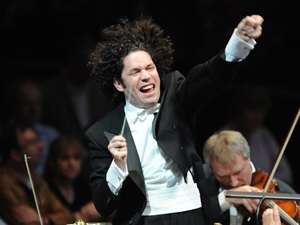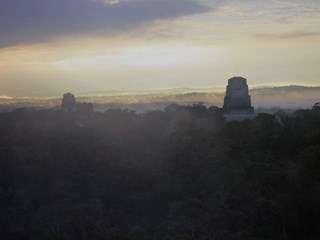|
Back
The Youths’ Magic Horns (And Drums And Strings Etc) New York
Isaac Stern Auditorium, Carnegie Hall
12/10/2012 -
Carlos Chávez: Sinfonía India
Julián Orbón: Tres versiones sinfónicas
Silvestre Revueltas: La Noche de los Mayas (Arranged by José Yves Limantour)
Simón Bolívar Symphony Orchestra of Venezuela, Gustavo Dudamel (Music Director and Conductor)

G. Dudamel (© Chris Christodoulou)
Did the sold-out audience in Carnegie Hall last night believe that Gustavo Dudamel create the Simón Bolívar Symphony Orchestra of Venezuela (SBSOV)? In literal fact, they were wrong, for this ensemble was created many years before, as a product of “El Sistema”, bringing music to some 300,000 Venezuelan young people. But in emotional fact, the international dynamo, Maestro Dudamel has such rapport, such understanding and such astounding control of the SBSOV, that, if not the creator, he was obviously their avatar.
That “control” is miraculous in himself. Not content with the paltry 120-odd paltry players of the NY Phil, the SBSOV has nearly 200 musicians stretching across the stage. Almost 100 strings, 90-odd brass and winds, and an astounding dozen percussionists, the latter so important to this heavily rhythmed evening.
The overall orchestral effects, while not lugubrious, could be heavy, even a bit cloggy, not the sounds which might illuminate a Mozart or Debussy. Yet when the music called for a few consorts, the ensemble was indeed impressive, reflecting Mr. Dudamel’s own electrifying conducting.
The large string section was technically excellent (reflecting the conductor’s own background as a violinist). On the other hand, the brass and winds didn’t make a single fluff, some solo cornet music was brilliant, and the whole group–including the solo tuba which uttered a lovely fart at the end of Julián Orbón’s first movement (no pun intended)–was actually understated until the three encores.
The orchestra is performing several nights during the first “Voices of Latin America”, for which Maestro Dudamel is Artistic Advisor. And last night’s concert, with three taxing works, showed an orchestra which had more than ebullience. Including the encores, it was a hemispheric compendium: composers from Mexico, Cuba, America, Argentina and, of course Venezuela.
The start was Carlos Chávez’ Sinfonía India, which in a short twelve minutes, included alleged melodies of different Mexican-Indian tribes and the usual (but always effective) rousing finale. I say ”alleged”, not because the melodies are ersatz but because lushly orchestrated oboes and strings, or clarinet (a marvelous solo) would be recognized. More important is that Chavez was able to take the two– or three-note themes and turn them into an orchestral bonanza.
More complicated was the sophisticated Orbón: Tres versiones sinfónicas. The composer, whose studies with Aaron Copland were apparent in the orchestration, took two medieval melodies for this first two movement, overlaying them with rich harmonies–and always keeping the Central American syncopated beats. The third movement, a Congolese-Cuban celebration, synthesis, was plainly out of place–and irrefutably the most brilliant section of brass, xylophone obligato, whirling strings and that fantastic percussion section.

Mayan Sunrise (© Coco T. Dawg)
The title of Silvestre Revueltas’ La Noche de los Mayas brought tears to my eyes, from having spent many days and nights in the Mayan ruins of Guatemala. The composition, from film music, didn’t come up to my personal reality (Guatemalan forests are notable for their utter silence). But it had a good balance of sentiment and a wild scherzo in the middle of the second movement.
For the last movement, though, Mr. Dudamel stood aside for an orgiastic cadenza by the entire SBSOV percussion section. This was neither pounding nor precise Stravinsky-Varèse style rhythm. Rather, it was a mysterious synthesis of instruments which no North American or European orchestra could possess. Outside of the usual bongos, snares, xylophone , and harp, we had a subtle tapestry of oddities like the guiro, huehuetl, sonajas, tumbadora and tumkul.
(Or so says the score. Like jazz, if you didn’t hear it, you wouldn’t recognize those names)
Actually, the cadenza was added later from other Revueltas films, but that made no difference, since the effects were a feverishly exciting ten minutes, and the buzzing orchestra which came in later did nothing to detract from the music, or the splendid players under Mr. Dudamel’s baton.
The first and last encores were by Arturo Márquez (Conga del Fuego Nuevo) and Mambo from West Side Story. But it was the middle encore, Alma Llanera by the Venezuelan composer Pedro Elías Gutiérrez, that gained most attention. Not only was the country’s flag unfurled in the audience, but many listeners cried, waved, sung and listened with enraptured attention.
“This song,” I was told , “is second only to our National Anthem. No party ends without everybody singing the Alma Llanera”.
She had it right. Gutavo Dudamel and his orchestra gave a party last night, with the élan, enthusiasm and energy of 200 young musicians at the top of their form.
Harry Rolnick
|